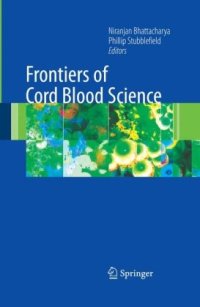
Ebook: Frontiers of Cord Blood Science
- Genre: Science (General) // Scientific-popular
- Tags: Hematology, Gene Therapy, Blood Transfusion Medicine, Transplant Surgery, Internal Medicine
- Year: 2009
- Publisher: Springer-Verlag London
- Edition: 1
- Language: English
- pdf
Since the first successful transplantation of umbilical cord blood in 1988, cord blood has become an important source of hematopoietic stem and progenitor cells for the treatment of blood and genetic disorders. Significant progress has been accompanied by challenges for scientists, ethicists, and health policy makers. With the recognition of the need for a national system for the collection, banking, distribution, and use of cord blood and the increasing focus on cord blood as an alternative to embryos as a source of tissue for regenerative medicine, it has garnered significant attention recently.
Frontiers in Cord Blood Science contains chapters from distinguished investigators currently engaged in researching cord blood in the treatment of various diseases of the brain, heart, liver, pancreas, bone and cartilage. The current state of research in the field is presented and the potential future applications of cord blood both for research and for the treatment of different diseases and conditions is discussed. In addition, the book reviews the possibility for novel uses in surgical wound healing and in synthetic grafts for reconstructive surgery, allowing their better adhesion.
Investigating the ethical issues, this book will be of interest to all scientists and researchers within the field of regenerative medicine and also clinicians in dermatology, neurology, cardiology and orthopedics wishing to discover more about the potential for the revolutionary medical approach of human umbilical cord blood.
Cord blood is a significant source of hematopoietic stem and progenitor cells for the treatment of blood and genetic disorders. Cord blood is also an alternative to embryos as a source of tissue for regenerative medicine. Cells from cord blood have been shown to transdifferentiate into nonhematopoietic cells, including those of the brain, heart, liver, pancreas, bone, and cartilage, in tissue culture and in animal systems. Recently it has been demonstrated that both cardiac and glial cell differentiation of cord blood donor cells occurred in recipients of unrelated donor cord blood transplantation as part of a treatment regime for Krabbe disease and Sanfilippo syndrome. These observations raise the possibility that cord blood may serve as a source of cells to facilitate tissue repair and regeneration in the future. CD34 stem cell-rich umbilical cord whole blood transfusion has the potential to have an immediate benefit of better tissue oxygenation with an additional delayed benefit of possible engraftment of umbilical cord stem cells.